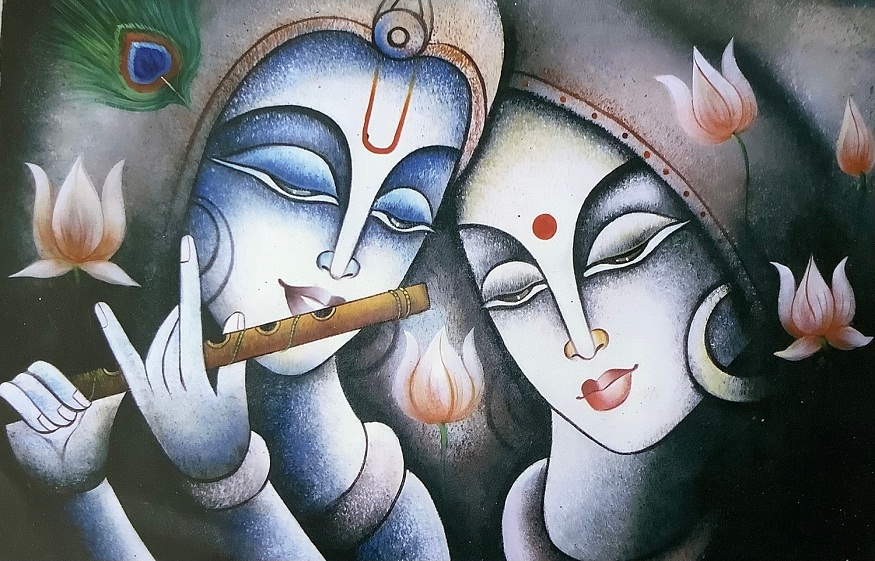Art is a timeless form of expression that captures emotions, spirituality, and the depths of human imagination. Over centuries, various artistic movements and styles have emerged, each bringing unique perspectives to the world of art. Among the most significant are Radha Krishna Paintings, Abstract Art Painting, and the legendary masterpieces of Vincent Van Gogh Painting. These forms of art, while distinct in their themes and execution, resonate with audiences on profound levels.
Radha Krishna Paintings: The Eternal Symbol of Love and Devotion
Historical and Cultural Importance
Radha Krishna Paintings hold a revered place in Indian art and spirituality. These artworks depict the divine love story between Lord Krishna and Radha, symbolizing devotion, eternal love, and the soul’s longing for the divine. Inspired by Hindu mythology, these paintings convey deep philosophical themes that continue to captivate generations.
Diverse Artistic Styles
Radha Krishna Paintings have evolved through different styles over the years. Some of the most famous variations include:
- Pichwai Paintings: Originating from Rajasthan, these intricate artworks often depict Krishna adorned in elaborate attire, surrounded by nature and gopis.
- Madhubani Art: A folk art form that uses bright colors and detailed patterns to narrate stories of Krishna’s life and divine love.
- Contemporary Interpretations: Modern artists often blend traditional and contemporary styles to present Radha Krishna Paintings in unique and innovative ways.
Significance in Homes and Temples
Having a Radha Krishna Painting in one’s space is believed to bring peace, harmony, and spiritual energy. These paintings serve as reminders of love’s purity and the divine connection between souls.
Abstract Art Painting: The Boundless Realm of Creativity
The Philosophy Behind Abstract Painting
Unlike traditional representational art, Abstract Art focuses on non-literal interpretations of reality. It emphasizes colors, forms, and textures to evoke emotions and ideas, making it one of the most expressive forms of artistic creation.
Key Styles and Techniques
Abstract Art Painting can be categorized into various styles, each conveying a different perspective:
- Expressionist Abstract Art: Uses bold brushstrokes and intense colors to communicate deep emotions.
- Geometric Abstraction: Composed of structured shapes and precise forms to create harmonious visual effects.
- Minimalist Abstraction: Focuses on simplicity and essential elements, stripping art down to its most fundamental components.
The Influence of Abstract Painting
Abstract Painting challenges traditional artistic conventions and invites viewers to interpret art based on their personal emotions and perceptions. It is widely used in modern interior design to add depth and intrigue to spaces.
Vincent Van Gogh Painting: The Legacy of Emotion and Color
A Glimpse into Van Gogh’s Artistic Journey
Vincent Van Gogh remains one of the most celebrated artists in history. His Vincent Van Gogh Painting collection is known for its expressive brushwork, vibrant colors, and deeply emotional undertones. His art reflects both his struggles and his profound connection to nature and humanity.
Masterpieces That Shaped Art History
Van Gogh’s paintings continue to inspire artists and art lovers alike. Some of his most iconic works include:
- Starry Night: A mesmerizing depiction of a swirling night sky, evoking a sense of wonder and introspection.
- Sunflowers: A vibrant representation of nature’s beauty, radiating warmth and positivity.
- The Bedroom: A personal and introspective piece reflecting solitude and inner turmoil.
The Lasting Impact of Van Gogh’s Art
Despite facing immense struggles during his lifetime, Van Gogh’s work laid the foundation for modern expressionism. His ability to convey emotion through color and movement has influenced countless artists and continues to be studied in art institutions worldwide.
Contrasting and Connecting These Artistic Styles
Although Radha Krishna Paintings, Abstract Art Painting, and Vincent Van Gogh Painting belong to different artistic traditions, they share the power to evoke deep emotions and artistic admiration.
- Spiritual vs. Emotional Expression: Radha Krishna Paintings focus on divine love and mythology, while Abstract Art Painting delves into raw emotion and conceptual depth. Van Gogh’s paintings bridge both, portraying personal emotions through intense colors and expressive strokes.
- Techniques and Form: Traditional Indian paintings emphasize intricate detailing and storytelling, Abstract Painting prioritizes freedom of form, and Van Gogh’s art is marked by thick impasto and dynamic brushstrokes.
- Cultural Significance: While Radha Krishna Paintings have religious and spiritual significance, Abstract Painting is more open-ended and experimental. Van Gogh’s work, meanwhile, represents a deeply personal and historical narrative.
Why These Art Forms Continue to Inspire
The universal appeal of Radha Krishna Paintings, Abstract Art Painting, and Vincent Van Gogh Painting lies in their ability to transcend time and culture. Whether through divine representation, emotional abstraction, or expressive storytelling, these artworks captivate audiences across generations.
For collectors and enthusiasts, owning these paintings means embracing the essence of artistic heritage, spirituality, and innovation. Whether displayed in homes, galleries, or temples, these artworks continue to inspire creativity and evoke profound contemplation.
Conclusion
Art is a powerful language that connects the human soul to creativity, emotion, and spirituality. Radha Krishna Paintings, with their divine essence, Abstract Art Painting, with its limitless expression, and Vincent Van Gogh Painting, with its intense emotions, all contribute uniquely to the world of art. Their timeless allure ensures that they remain treasured masterpieces, continuing to inspire and transform artistic perspectives across the world.



